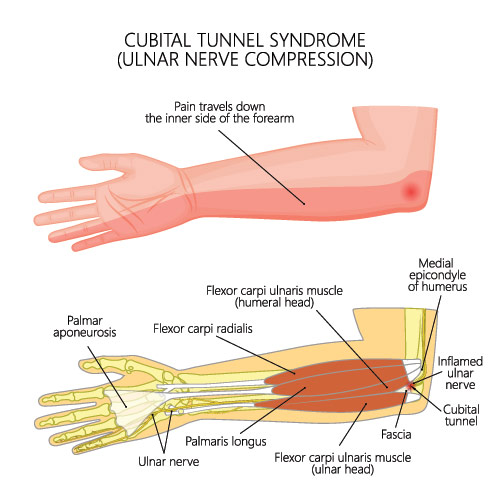Ulnar Nerve Compression

The ulnar nerve supplies sensation to your ring and little fingers and power to the small muscles in your hand. It passes behind your elbow and runs through a narrow passageway called the cubital tunnel. Cubital tunnel syndrome arises as a result of compression of nerve within this tunnel.
In the early stages, occasional pins and needles in your ring and little fingers are common. They can occur at night, waking you from your sleep. If the nerve remains compressed for a long time, numbness and muscle wasting can develop. The latter causes weakness and difficulty in straightening your fingers.
Surgery for cubital tunnel syndrome is a definitive treatment that will eliminate those troublesome pins and needles and prevent irreversible nerve damage.

FAQs
The surgery is performed under general anaesthetic on a day case basis. It involves making an incision along the inside of your elbow and dividing the roof of the cubital tunnel. This reduces the pressure on the nerve by providing more space for it to move. In some patients, as the elbow moves through flexion and extension, the nerve has a tendency to snap back and forth over the bony bump on the inside of the elbow. In such cases, the nerve is moved forwards and fixed in a position that prevents this. The wound is closed with dissolvable stitches and a splint is applied. The procedure takes between one to two hours.
Identifying and avoiding actions that trigger your symptoms, in addition to physiotherapy, anti-inflammatory medications and wearing a splint and protective padding around your elbow can provide some relief. If your symptoms persist despite conservative measures, or if severe nerve compression is present, the problem should be dealt with surgically to prevent irreversible damage.
Some discomfort is to be expected after the surgery and Dr Collins will ensure you have adequate pain relief to deal with this. You will remain in a splint for two weeks and you will not be able to drive for this period. Dr Collins will refer you to a hand therapist to ensure you get the best possible functional outcome. This can take up to six weeks and sometimes longer.
Your return to work will be determined by the type of job that you do. Patients in a supervisory or managerial role may be able to return to work after 2-3 weeks. If your work is more physically demanding, you may require 6 weeks or more of leave.

